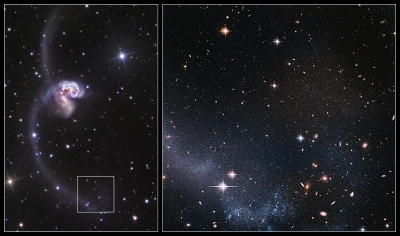The Antennae Galaxies found to be closer to us [heic0812]
9 May 2008
New research on the Antennae Galaxies using the Advanced Camera for Surveys onboard the NASA/ESA Hubble Space Telescope shows that this proto-typical pair of interacting galaxies is in fact much closer to us than previously thought - at 45 million light-years instead of 65 million light-years.The Antennae Galaxies are among the closest known merging galaxies. The merging pair of galaxies, NGC 4038 and NGC 4039, began interacting a few hundred million years ago, creating one of the most impressive sights in the night sky. They are considered by scientists as the archetypal merging galaxy system and are used as a standard against which to validate theories about galaxy evolution.
An international group of scientists led by Ivo Saviane from the European Southern Observatory has used Hubble's Advanced Camera for Surveys and Wide Field Planetary Camera 2 to observe individual stars spawned by the colossal cosmic collision in the Antennae Galaxies. They reached an interesting and surprising conclusion. By measuring the colours and brightnesses of red giant stars in the system, the scientists found that the Antennae Galaxies are much closer to us than previously thought: residing at a distance of 45 million light-years instead of the previous best estimate of 65 million light-years.
 |
|
The Antennae Galaxies (left) and the region imaged with Hubble in the study by Saviane et al. (right) |
The team targeted a region in the relatively quiescent outer regions in the southern tidal tail, away from the active central regions. This tail consists of material thrown from the main galaxies as they collided. The scientists needed to observe regions with older red giant stars to derive an accurate distance. Red giants are known to reach a standard brightness, which can then be used to infer their distance from the difference between the intrinsic and observed brightness. The method is known as the tip of the red giant branch (TRGB).
The proximity of the Antennae system means it is the best-studied galaxy merger in the sky, with a wealth of observational data to be compared to the predictions of theoretical models. Saviane says: "All aspiring models for galaxy evolution must be able to account for the observed features of the Antennae Galaxies, just as respectable stellar models must be able to match the observed properties of the Sun. Accurate models require the correct merger parameters, and of these, the distance is the most essential".
The previous canonical distance to the Antennae Galaxies was about 65 million light-years although values as high as 100 million light years have been used. Our Sun is only eight light-minutes away from us, so the Antennae Galaxies may seem rather distant, but if we consider that we already know of galaxies that are more than ten thousand million light-years away, the two Antennae Galaxies are really our neighbours.
The previous larger distance required astronomers to invoke some quite exceptional physical characteristics to account for the spectacular system: very high star-formation rates, supermassive star clusters, ultraluminous X-ray sources etc. The new smaller distance makes the Antennae Galaxies less extreme in terms of the physics needed to explain the observed phenomena. For instance, with the smaller distance its infrared radiation is now that expected of a "standard" early merging event rather than that of an ultraluminous infrared galaxy. The size of the star clusters formed as a consequence of the Antennae merger now agree with those of clusters created in other mergers instead of being 1.5 times as large.
The Antennae Galaxies are named for the two long tails of stars, gas and dust that resemble the antennae of an insect. These "antennae" are a physical result of the collision between the two galaxies. Studying their properties gives us a preview of what may happen when our Milky Way galaxy collides with the neighbouring Andromeda galaxy in several thousand million years. Although galaxy mergers today are not common, it is believed that in the past they were an important channel of galaxy evolution. Therefore understanding the physics of galaxy mergers is a very important task for astrophysicists.
The Antennae are located in the constellation of Corvus, the Crow.
The findings appeared in the 1 May 2008 issue of The Astrophysical Journal.
Notes for editors
The Hubble Space Telescope is a project of international cooperation between ESA and NASA.
The authors of the science paper are: Ivo Saviane (European Southern Observatory), Yazan Momany (Osservatorio Astronomico di Padova, Italy), Gary S. Da Costa (Research School of Astronomy and Astrophysics, Australia), R. Michael Rich (Department of Physics and Astronomy, USA) and John E. Hibbard (National Radio Astronomy Observatory, USA)
Image credit: NASA, ESA & Ivo Saviane (European Southern Observatory)
Contact
Ivo Saviane
European Southern Observatory, Santiago, Chile
Cell: +39 333 77 08 761 (Italy/CEST time zone)
E-mail: isaviane eso.org
eso.org
Gary S. Da Costa
Research School of Astronomy & Astrophysics, ANU, Australia
Tel: +61-2-6125-8913
E-mail: gdc mso.anu.edu.au
mso.anu.edu.au
Lars Lindberg Christensen
Hubble/ESA, Garching, Germany
Tel: +49-(0)89-3200-6306
Cell: +49-(0)173-3872-621
E-mail: lars eso.org
eso.org

